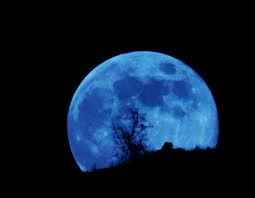
The first full Moon of 2020 howls onto the scene with January’s Wolf Moon on January 10th. And usually, we have one for each month, making the total 12 for the year. But on occasion, some months will have two full Moons. This is the case for October 2020: we’ll have a full Moon on Thursday, October 1st and again on Saturday, October 31st—a Halloween full Moon—which is not only rare in and of itself, but it will also be considered a “Blue Moon” because it’s the second full Moon of the same month.
For more than half a century, whenever two full Moons appeared in a single month (which happens on average every 2 1/2 to 3 years), the second has been christened a “Blue Moon.” In our lexicon, we describe an unusual event as happening “Once in a Blue Moon.” This expression was first noted back in 1821 and refers to occurrences that are uncommon, though not truly rare.
When you look at the full Moon on Halloween night, it won’t appear blue in color but you’ll be looking at something pretty uncommon. A full Moon on Halloween only occurs roughly once every 19 years (known as a Metonic cycle). If the full Moons are calculated using Greenwich Mean Time, that translates to approximately 3-4 times per century. So maybe the phrase “once in a Blue Moon” really belongs to a full Moon on Halloween!
There is an alternate definition of a “Blue Moon,” which is based on a seasonal rule rather than a monthly rule: Normally, there are three full Moons each season of the year. But when a particular season ends up containing four full Moons, the third then is referred to as a ‘Blue Moon.”
For a Supermoon to occur, we can thank the shape of the Moon’s orbit, which is not a perfect circle, but an oval shape. That means when the Moon orbits the Earth each month, it reaches a point that’s farthest from the Earth, called apogee, and a point where it swings closest to Earth, called perigee.
According to how most people define a Supermoon, it occurs when the Moon is at least 90% of the way to its perigee position at the same time it is in its “full” phase.



